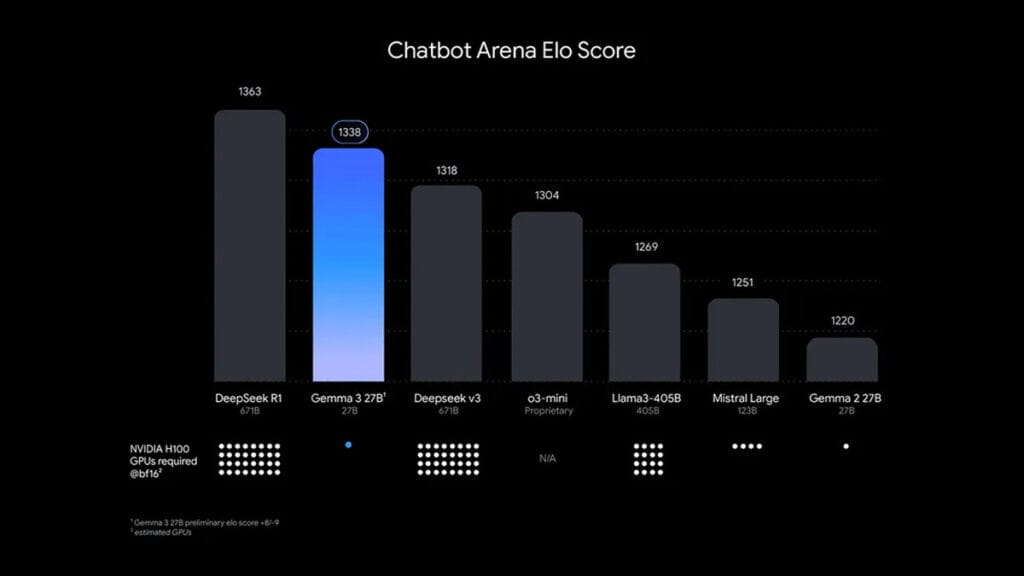What is Google Gemma 3?
Google Gemma 3 is the newest iteration in the Gemma family of open models, built upon the same research and technology that powers Google’s Gemini models. It’s designed to be lightweight, cutting-edge, and accessible to developers and researchers. It offers a powerful tool for a wide range of AI applications. Unlike closed models, Gemma 3’s open nature fosters collaboration and innovation, allowing the community to build upon its foundation. Gemma 3 is a finely tuned engine ready to be integrated into various projects, from simple applications to complex research endeavours. Google has made it a priority to provide a model that is both high-performing and user-friendly, ensuring that a broader audience can benefit from advanced AI capabilities.
Gemma 3 Features and Capabilities
Gemma 3 brings a suite of features that set it apart. First, it demonstrates significant improvements in performance across various benchmarks, including natural language understanding, reasoning, and code generation. Imagine a model that can understand complex text, generate creative content, and assist in coding tasks with greater accuracy. The model’s architecture has been optimised for efficiency, allowing it to run smoothly on various hardware, from laptops to cloud servers. This flexibility is crucial for developers deploying AI solutions in diverse environments.
Moreover, Gemma 3 supports an enhanced multi-modal form of the model. Initially, it was entirely a language model. Still, it can now effectively be integrated with other modalities, such asio. Therefore, this enables the creation of applications that can process and understand data from numerous sources; thus, it is now possible to develop new robotics, interactive media, and personalised learning. The model’s versatility is another crucial factor. Programmers can modify Gemma 3 for particular jobs and fields. For that, they can have their purposes met by the machines. Gemma 3’s high level of customisation ensures that it is helpful in a great variety of industries, such as health care and finance.

Advancing Responsible AI
Google made a decisive statement stressing responsible AI development with Gemma 3. This model has been rigorously tested and examined to minimise biases and ensure fairness. Safety protocols are built into the model’s architecture, which acts as a barrier to generating harmful or inappropriate content. Google has raised attention to the fact that open models can be abused. Hence, they have put forth a lot of documentation and tools to promote ethical use. The company urges developers to consider how their AI applications can contribute to society and how they can be developed responsibly.
Gemma 3 is also a product that has been intended transparently. In the course of fashioning the pattern of the model and the training data, these were all documented to help the researchers figure out the causes for why it works and let them bring into daylight the existing problems as well. In this way, transparency will act as the driving force for the AI technology to be trusted and for the ethical issues to be addressed by no full-on collisions but rather in a collaborative way. Moreover, Google’s responsibility for ethical AI is realised in the model, and it engages in hosting workshops and providing resources to the AI community. The point of view of being the one that starts and not being the one that tries to fix things when they have already begun to is what is underlined in this proactive approach, which juxtaposes Google. This approach shows that Google is highly concerned about ensuring that AI flourishes and brings benefits to everyone on Earth.
How Google Gemma 3 Compares with Other AI Models
Several key distinctions emerge when comparing Google Gemma 3 with other AI models. First, its open nature sets it apart from many proprietary models. Accessibility allows researchers and developers to explore its capabilities and contribute to its development freely. The model’s lightweight nature also makes it more accessible to people with limited hardware.

Second, Gemma 3’s performance across benchmarks demonstrates its competitiveness with state-of-the-art models. Its ability to handle complex tasks, such as reasoning and code generation, positions it as a versatile tool for various applications. Third, the model’s emphasis on responsible AI development distinguishes it from models prioritising performance at the expense of ethical considerations. Google’s proactive approach to addressing biases and promoting fairness sets a new standard for open AI models.
In innovation, you cannot just go out there and muddle through while driving your new wheel. Others might emphasise one particular strength, but in the case of Gemma 3, there is a unique combination of performance, ethical issues, and accessibility. There are models, on the one hand, which show higher performance in the case of specific tasks. Still, they are far from what Gemma 3 provides because of the lack of transparency and moral safeguards. The others may be accessible to some extent, but the capacities are minimal in such areas. In reality, the AI model selection is heavily influenced by the application’s exact needs. Nonetheless, the Google Gemma 3 is an essential step in AI technology as it is a more sophisticated and responsible tool for the community of developers and researchers.
FAQs:
What are the main benefits of using Google Gemma 3 over other AI models?
Gemma 3 offers a unique blend of high performance, open accessibility, and a strong focus on responsible AI. Its open nature allows developers and researchers to freely explore and build upon the model, fostering collaboration and innovation. The model’s efficiency will enable it to run on various hardware. Additionally, Google’s emphasis on minimising biases and promoting ethical use sets Gemma 3 apart, ensuring that AI development is robust and responsible.
Can Google Gemma 3 be used for commercial applications?
Yes, Google Gemma 3 is designed to be accessible for research and commercial use. Developers can fine-tune the model for specific tasks and domains, making it adaptable to various industries and applications. However, users are encouraged to review Google’s terms of service and guidelines for responsible use to ensure compliance and ethical practices.
What kind of hardware is needed to run Google Gemma 3 effectively?
Gemma 3 is optimised for efficiency, allowing it to run on various hardware, from standard laptops to cloud servers. The specific hardware requirements will depend on the size of the model and the complexity of the tasks being performed. Google provides documentation and resources to help developers understand the hardware considerations and optimise performance for their needs.





